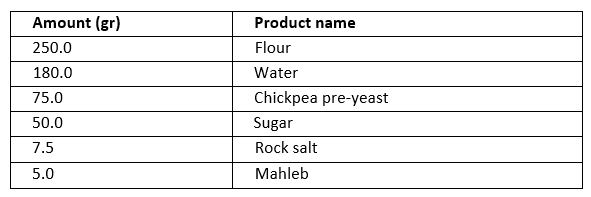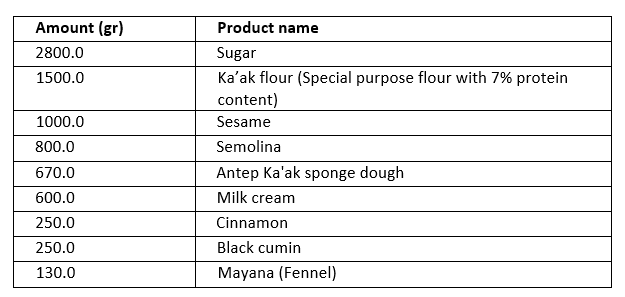Antep Village Ka'ak Protected Geographical Indication
Tuesday, July 5, 2022
No: 291 – Protected Geographical Indication (PGI)
ANTEP VILLAGE KA’AK
(GAZIANTEP VILLAGE KA’AK)
Registrant
GAZIANTEP EXCHANGE COMMODITY
This geographical indication was registered on 25.12.2017 to be protected as of 14.07.2017 under the Industrial Property Law No. 6769.
Registration Number : 291
Registration Date : 25.12.2017
Application Number : C2017/059
Application Date : 14.07.2017
Name of Geographical Indication : Antep Village Ka'ak (Gaziantep Village Ka'ak)
Product / Product Group : Ka'ak / Bakery and pastry products, sweets
Type of Geographical Indication : Protected Geographical Indication (PGI)
Registrant : Gaziantep Commodity Exchange
Address of Registrant : Sanayi Mah. 60092 No'lu Sok. Bina No: 15 Şehitkâmil Gaziantep
Geographical Boundary : Gaziantep Province
Usage Format : The geographical indication can be placed on the product together with the brand
where the brand of the product is used.

Product Description and Distinctive Features:
Antep Village Ka'ak is a special cookie made in Gaziantep, especially during Ramadan Feasts, containing spices such as mayana (fennel), black cumin, cinnamon and sesame. It is produced by special processes with chickpea yeast. It is a product that dissolves in the mouth and maintains its freshness for 3-4 months. The most important factor in maintaining its freshness is that the fermentation process is different from other cookies.
Ka'ak was brought from the city of Aleppo in Syria by the bakers of Antep in the early 1900s, and it is known as a product that was first made to make children like fasting during Ramadan. Both savory and sweet varieties of Antep Ka'ak are made. Antep Village Ka'ak, which is the subject of the registration, is a sweet type of ka'ak. The most special feature of Antep Village Ka'ak is that it is made with chickpea yeast. Chickpea yeast causes Antep Village Ka'ak to gain a structure that is dispersible in the mouth and prolongs its durability. In addition, the spices used and the shape of the ka'ak give the product its distinctive features.
Production Method:
1- Chickpea Yeast Preparation: Chickpea yeast is an odorous, sweet yeast that is formed by the fermentation of chickpeas by breaking them into pieces, and takes less time to make and is easier to make than sour yeast.
The amounts indicated in Table 1 are for approximately 500 grams of chickpea yeast.
Table 1. Ingredients for chickpea yeast

Chickpea yeast should be prepared and ready for use at least one night prior to making Antep Village Ka'ak. The production of the yeast should be started by cutting the chickpeas into 4-5 parts, until the chickpeas are in the form of broken grains.
Fragmented chickpeas are placed in a glass jar that has been shaken with boiling water in it beforehand. Flour and salt are sprinkled on it and it is shaken slightly, letting it mix and take air in. Then, water (45-46°C) is added. The water added should end 2.5-3.0 cm above the yeast mixture. The amount of water doesn't matter, it should only be ensured that the yeast mixture is well covered. The glass jar is closed not too tightly. It is left to ferment overnight, for approximately 15-16 hours. During the fermentation period, the environment should be around 45-46°C. After starting to ferment, yeast starts to foam within 3-4 hours. When the fermentation period is completed, the foam accumulated across the yeast is collected and removed. This foam is used in later stages. Yeast pulp is not used in the making of Antep Village Ka'ak. The yeast called pre-yeast is prepared with the foam obtained.
2- Chickpea pre-yeast preparation:
- 200 gr Ka’ak flour (Special purpose flour with 7% protein content)
-200 gr Drinking water
-All of the active yeast foam obtained
All of the ingredients mentioned above are thoroughly mixed. Then the mixture is covered and allowed to rest for 2-3 hours. When air bubbles appear on the pre-yeast, it means that it is ready for use. Depending on the amount of Antep Village Ka'ak to be made, the last obtained pre-yeast can be multiplied by adding water and flour and allowing it to ferment for 2-3 hours again. Chickpea pre-yeast to be used in Antep Village Ka'ak dough should be prepared and ready for use 1 day prior to Antep Village Ka'ak production.
3- Pre-dough preparation:
All of the pre-dough ingredients are put into a bowl and mixed. It is kneaded for about 3-5 minutes and left to rest for 1 day to swell. The average fermentation temperature of this yeast is 42-46°C and fermentation time is 3-4 hours. After the pre-dough is formed, it is preferably rested for 1 more day. The materials indicated in Table 2 are the amount of ingredients required for the pre-dough used in the production of approximately 550 grams of Antep Village Ka'ak.
Table 2. The ingredients and their amounts required for the pre-dough necessary for Antep Village Ka'ak

After the pre-dough is prepared, the main dough is made.
4- Making the main dough for Antep Village Ka'ak:
The kneading process begins by mixing first the flour and then the pre-yeast in the same mixing bowl. When the dough reaches a nice consistency, olive oil is added and kneaded in. Then, the milk cream, which is kept and softened at room temperature, is added. Milk cream must be in accordance with the Communiqué on Milk and Dairy Products and the Turkish Food Codex. After the kneading process is finished, the dough should be kept at room temperature for 1-2 hours. Table 3 shows the 8 kg Main Dough components required for Antep Village Ka'ak.
Table 3. The ingredients and their amounts required for the main dough necessary for Antep Village Ka'ak

5- Getting Antep Ka'ak ready for cooking
Pieces of about 17 gr are cut off from the dough, and shaped into rings. The shaped Antep Village Ka'ak doughs are arranged in intervals that will not allow them to touch each other as they rise on the teflon tray. A whole scrambled egg is brushed on Antep Village Ka'ak.
6- Cooking
The dough trays are kept at 42-45°C for about 2 hours and then placed in the oven preheated to 180°C. Cooking time is about 20-25 minutes. Cooking is complete when Antep Village Ka'ak is lightly browned on the top and bottom. It will be very fragile when taken out of the oven. Therefore, trays should not be emptied immediately. The Antep Village Ka'aks obtained should be kept at room temperature and then carefully removed from the tray and served.
The Production, Processing and Other Transactions to be Performed within the Geographical Boundary:
The materials to be used in the production of Antep Village Ka'ak, their proportions and the production method must be in accordance with those specified in this registration.
Inspection:
The supervisory authority consists of 5 experts working in the Ministry of Food, Agriculture and Livestock, Gaziantep Provincial Directorate, Gaziantep Gastronomy and Tourism Association, Gaziantep Restaurants, Kebab Shops, Pastry Shops, Pastry Shops and Baklava Shops, Gaziantep University Faculty of Fine Arts, Department of Gastronomy and Culinary Arts, under the coordination of Gaziantep Commodity Exchange.
The team will be inspecting whether Antep Ka'ak is produced in accordance with the specified specifications, in accordance with the Law No. 6769.
1- Inspection of the amount of doughs, yeasts and other materials used for the production of Antep Ka'ak
2- Checking the appropriateness of Antep Ka'ak fermentation and cooking times
Inspections will be carried out periodically by the supervisory authority every year, whenever deemed necessary and in the case of a complaint.
The supervisory authority may benefit from or purchase services of public or private institutions, or natural or private entities in charge, during the execution of the inspection. The registrant carries out the legal processes for the protection of rights.

Original text from ci.gov.tr.












